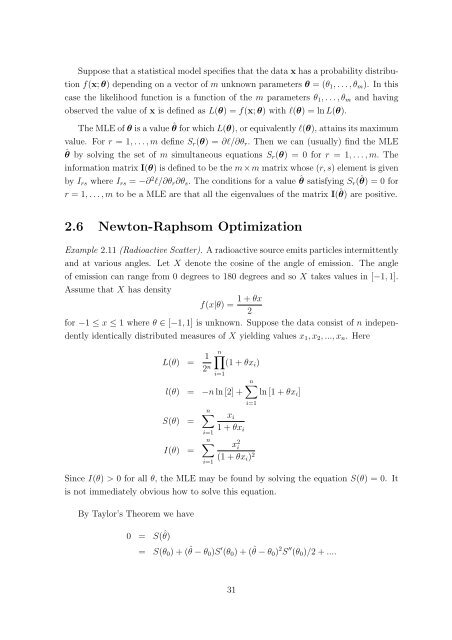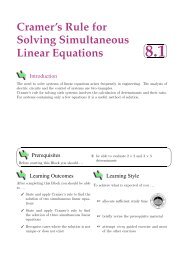Student Notes To Accompany MS4214: STATISTICAL INFERENCE
Student Notes To Accompany MS4214: STATISTICAL INFERENCE
Student Notes To Accompany MS4214: STATISTICAL INFERENCE
You also want an ePaper? Increase the reach of your titles
YUMPU automatically turns print PDFs into web optimized ePapers that Google loves.
Suppose that a statistical model specifies that the data x has a probability distribu-<br />
tion f(x; θ) depending on a vector of m unknown parameters θ = (θ1, . . . , θm). In this<br />
case the likelihood function is a function of the m parameters θ1, . . . , θm and having<br />
observed the value of x is defined as L(θ) = f(x; θ) with ℓ(θ) = ln L(θ).<br />
The MLE of θ is a value ˆ θ for which L(θ), or equivalently ℓ(θ), attains its maximum<br />
value. For r = 1, . . . , m define Sr(θ) = ∂ℓ/∂θr. Then we can (usually) find the MLE<br />
ˆθ by solving the set of m simultaneous equations Sr(θ) = 0 for r = 1, . . . , m. The<br />
information matrix I(θ) is defined to be the m×m matrix whose (r, s) element is given<br />
by Irs where Irs = −∂ 2 ℓ/∂θr∂θs. The conditions for a value ˆ θ satisfying Sr( ˆ θ) = 0 for<br />
r = 1, . . . , m to be a MLE are that all the eigenvalues of the matrix I( ˆ θ) are positive.<br />
2.6 Newton-Raphsom Optimization<br />
Example 2.11 (Radioactive Scatter). A radioactive source emits particles intermittently<br />
and at various angles. Let X denote the cosine of the angle of emission. The angle<br />
of emission can range from 0 degrees to 180 degrees and so X takes values in [−1, 1].<br />
Assume that X has density<br />
1 + θx<br />
f(x|θ) =<br />
2<br />
for −1 ≤ x ≤ 1 where θ ∈ [−1, 1] is unknown. Suppose the data consist of n indepen-<br />
dently identically distributed measures of X yielding values x1, x2, ..., xn. Here<br />
L(θ) = 1<br />
2 n<br />
n�<br />
(1 + θxi)<br />
i=1<br />
l(θ) = −n ln [2] +<br />
S(θ) =<br />
I(θ) =<br />
n�<br />
i=1<br />
n�<br />
i=1<br />
xi<br />
1 + θxi<br />
n�<br />
ln [1 + θxi]<br />
i=1<br />
x 2 i<br />
(1 + θxi) 2<br />
Since I(θ) > 0 for all θ, the MLE may be found by solving the equation S(θ) = 0. It<br />
is not immediately obvious how to solve this equation.<br />
By Taylor’s Theorem we have<br />
0 = S( ˆ θ)<br />
= S(θ0) + ( ˆ θ − θ0)S ′ (θ0) + ( ˆ θ − θ0) 2 S ′′ (θ0)/2 + ....<br />
31






